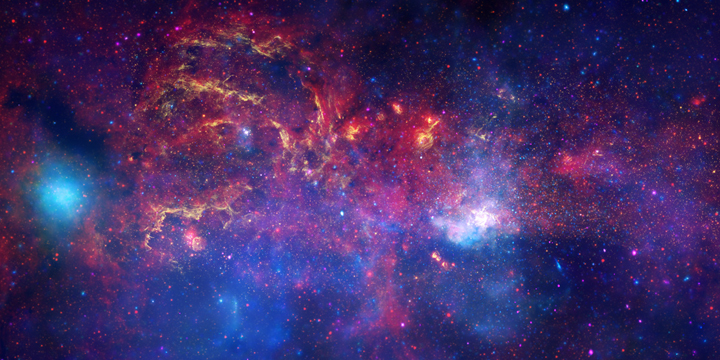Our Galaxy
in Many Kinds of Light
26,000 light years

Image Credit: X-ray: NASA/CXC/UMass/D. Wang et al.; Optical: NASA/ESA/STScI/D.Wang et al.; IR: NASA/JPL-Caltech/SSC/S.Stolovy
Light takes on many forms—from radio to infrared to X-rays and more. And the Universe tells its story through all of these different types of radiation. So, in order to really understand the cosmos, astronomers need many different kinds of telescopes.
This image of the center of our Milky Way galaxy combines data from three NASA observatories. X-rays from the Chandra X-ray Observatory are blue and violet, near-infrared emission from Hubble is yellow, and the Spitzer Space Telescope infrared data are red. Observations using infrared light and X-ray light see through the obscuring dust to reveal the intense activity near the galactic core. Near-infrared emission outlines the energetic regions where stars are being born as well as reveal hundreds of thousands of stars.
Listen to audio version (English)
Download high-res image file | Download caption as .zip file
Nuestra galaxia en muchos tipos de luz - 26,000 años luz de la Tierra
La luz tiene muchas formas -desde radio hasta el infrarrojo, los rayos X y más. Y el Universo cuenta su historia a través de todos estos diferentes tipos de radiación. Así, que para entender realmente el cosmos, los astrónomos necesitan diferentes tipos de telescopios.
Esta imagen del centro de nuestra galaxia, la Vía Láctea combina datos de tres observatorios de la NASA. Los rayos X del Observatorio Chandra de Rayos X son azul y violeta, la emisión en el infrarrojo cercano de Hubble es de color amarillo, y los datos infrarrojos del Telescopio Espacial Spitzer son rojos. Observaciones utilizando luz infrarroja y la luz de rayos X pueden ver a través del polvo para revelar la actividad intensa cerca del núcleo galáctico. Emisión en el infrarrojo cercano esbozan las regiones energéticas donde las estrellas están naciendo, así como revelan cientos de miles de estrellas.
Download high-res image file | Download caption as .zip file



